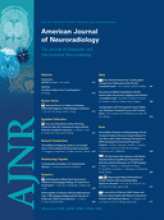Paragangliomas of the neck are rare somatostatin receptor-expressing neuroendocrine tumors. Somatostatin-receptor scintigraphy is useful in diagnosing and staging these tumors, as well as assessing residual or recurrent disease posttreatment. We describe the gallium 68 DOTA, DPhe1, Tyr3-octreotate positron-emission tomography-CT (68Ga-DOTATATE PET-CT) findings of bilateral neck paragangliomas as seen in the following patient.
A previously healthy 40-year-old woman presented with asymmetric sensorineural hearing loss, right more than left, which was confirmed on an audiogram. There was no other neurologic deficit. MR imaging of the internal auditory meati did not reveal any abnormality at the cerebellopontine angles or internal auditory canals; however, a left carotid space mass was partially visualized. A dedicated MR image of the neck revealed avidly enhancing lobulated masses within bilateral carotid spaces (Figs 1 and 2 A). The right neck mass extended from the level of the carotid bifurcation to the level of the nasopharynx and splayed the right internal and external carotid arteries. The left neck mass extended from the level of the oropharynx to the left jugular foramen, splaying the left internal jugular vein and internal carotid artery. 68Ga-DOTATATE PET-CT demonstrated intense tracer uptake within the bilateral carotid space masses (Fig 2B). There was no other abnormal focus of increased tracer uptake in the rest of the body to suggest the presence of metastasis. These imaging findings confirmed a right carotid body tumor and a left glomus vagale. Biochemical screening revealed elevated urine norepinephrine (622 nmol/day; normal, 89–473 nmol/day) and normetanephrine (2895 nmol/day; normal, 600-1900 nmol/day) levels. The patient opted for and is scheduled to undergo radiation therapy.
Axial T1-weighted contrast-enhanced MR images reveals avidly enhancing lobulated masses in the bilateral carotid spaces of the neck, containing serpiginous signal-intensity voids.
Coronal T1-weighted contrast-enhanced MR image (A) and coronal 68Ga-DOTATATE PET-CT image (B) reveal intense tracer uptake within the enhancing bilateral carotid space masses.
DOTATATE is a somatostatin analog, which can be radio-labeled with 68Ga. 68Ga is a positron emitter with a half-life of 68 minutes, produced by elution from 68Ge in a 68Ga generator. 68Ga-DOTATATE shows a high affinity for somatostatin type 2 receptors (SSR-2), is rapidly excreted from nontarget sites, and offers good target-to-nontarget imaging properties. Compared with indium 111-diethylene triamine pentaacetic acid-octreotide, 68Ga-DOTATATE demonstrates better sensitivity for neuroendocrine tumors1 and is useful for the diagnosis of small tumors and evaluation of disease response following therapy.2 The mainstay of treatment for paragangliomas in the head and neck region has been surgical resection, preoperative embolization, and/or external beam radiation therapy, though a role for stereotactic radiosurgery is emerging.3 There is also a promising role for peptide-receptor radionuclide therapy, where the somatostatin analog DOTATATE is radio-labeled with the β emitter lutetium 177 (177Lu) to deliver highly targeted doses to tumors expressing the SSR-2, with low doses to the normal organs.4
Our case highlights the intense and specific tracer uptake of 68Ga-DOTATATE in paragangliomas of the neck, which will be useful if findings on other imaging modalities are equivocal. There is also a promising role for using 177Lu-DOTATATE for highly targeted radionuclide therapy of these tumors.
References
- Copyright © American Society of Neuroradiology














